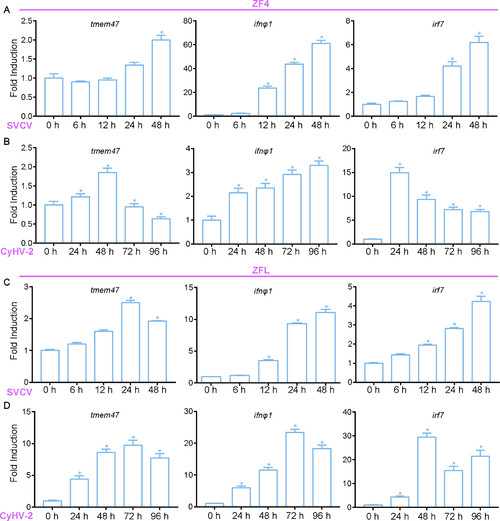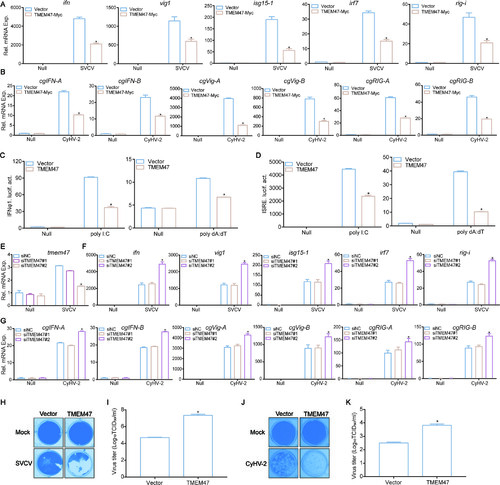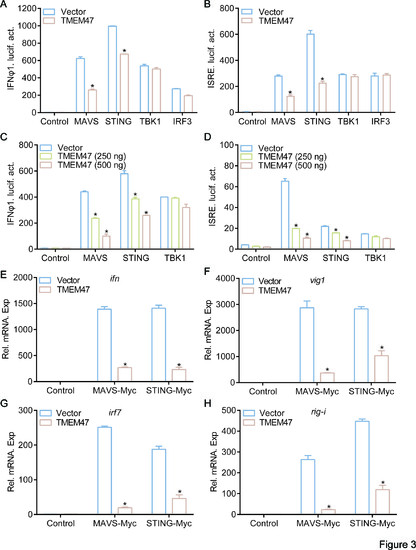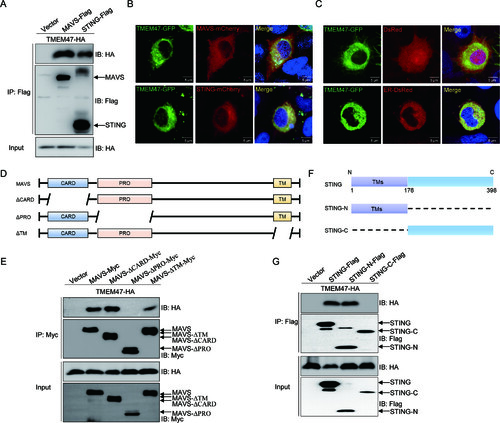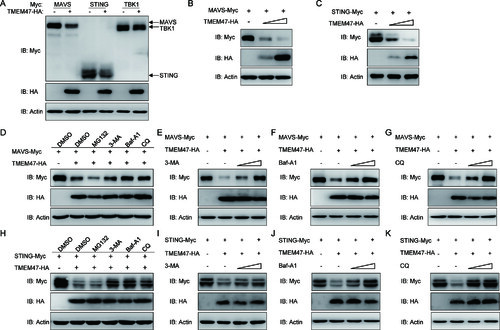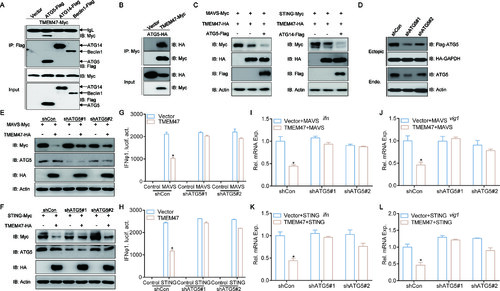- Title
-
Zebrafish TMEM47 is an effective blocker of IFN production during RNA and DNA virus infection
- Authors
- Lu, L.-.F., Li, Z.-.C., Zhang, C., Chen, D.-.D., Han, K.-.J., Zhou, X.-.Y., Wang, X.-.L., Li, X.-.Y., Zhou, L., Li, S.
- Source
- Full text @ J. Virol.
|
TMEM47 is stimulated by virus infection. (A–D) Quantitative PCR (qPCR) detection of the transcriptional levels of tmem47, ifnφ1, and irf7 on SVCV or CyHV-2 stimulation. ZF4 cells (A and B) or ZFL cells (C and D) were seeded on six-well plates overnight and stimulated with SVCV [multiplicity of infection (MOI) = 1] or CyHV-2 (MOI = 0.01). At the time points 0, 6, 12, 24, and 48 h, total RNAs were extracted for further qPCR assays. β-actin was used as an internal control for normalization, and the relative expression is represented as fold induction relative to the expression level in control cells (set to 1). Data were expressed as mean ± standard error of the mean (SEM), n= 3. Asterisks indicate significant differences from control (*P < 0.05). All experiments were repeated for at least three times with similar results. |
|
Overexpression of TMEM47 blocks IFN induction. (A) TMEM47 inhibits the expression of epc ifn, epc vig1, epc isg15-1, epc irf7, and epc rig-i induced by SVCV. EPC cells seeded in six-well plates overnight were transfected with 2 µg TMEM47-Myc or empty vector and treated with SVCV (MOI = 1) at 24 h post-transfection. At 24 h after stimulation, total RNAs were extracted for further qPCR assays. (B) TMEM47 blocks the expression of cgIFN-A, cgIFN-B, cgVig-A, cgVig-B, cgRIG-A, and cgRIG-B induced by CyHV-2. Gibel carp brain (GiCB) cells seeded in six-well plates overnight were transfected with 2 µg TMEM47-Myc or empty vector and infected with CyHV-2 (MOI = 0.001) at 24 h post-transfection. At 48 h after stimulation, total RNAs were extracted for further qPCR assays. (C and D) TMEM47 suppresses poly I:C/poly dA:dT-induced IFNφ1pro/ISRE activation in a dose-dependent manner. EPC cells were seeded in 24-well plates overnight and then transfected with 250 ng IFNφ1pro-Luc (C) or ISRE-Luc (D) and 50 ng pRL-TK, plus 250 ng pcDNA3.1-TMEM47 (250 ng or 100/250/500 ng) or pcDNA3.1(+) (control vector). At 24 h post-transfection, cells were untreated (null) or transfected with poly I:C (0.5 µg) or poly dA:dT (0.5 µg). Luciferase activities were monitored at 24 h after stimulation. The promoter activity is presented as relative light units (RLU) normalized to Renilla luciferase activity. (E) Effects of TMEM47 RNA interference (RNAi) on the expression of endogenous TMEM47. EPC cells were seeded in six-well plates overnight and transfected with 100 nM siTMEM47#1, siTMEM47#2, or siNC (negative control). At 24 h post-transfection, the cells were treated with SVCV (MOI = 1). At 24 h post-stimulation, total RNAs were extracted to examine the transcriptional levels of tmem47. (F and G) Effects of TMEM47 RNAi on the SVCV/CyHV-2-induced IFN and other ISGs transcription. EPC or GiCB cells were seeded in six-well plates and transfected with 100 nM siNC, siTMEM47#1, or siTMEM47#2. At 24 h post-transfection, cells were treated with SVCV for 24 h or CyHV-2 for 48 h before qPCR analysis was performed. (H–K) EPC or GiCB cells seeded in 24-well plates overnight were transfected with 0.5 µg TMEM47-Myc or empty vector. At 24 h post-transfection, cells were infected with SVCV (MOI = 0.001) for 48 h or CyHV-2 (MOI = 0.001) for 72 h. Then, cells were fixed with 4% paraformaldehyde (PFA) and stained with 1% crystal violet (H and J). Culture supernatants from the cells infected with SVCV or CyHV-2 were collected, and the viral titer was measured according to the method of Reed and Muench (I and K). Data were expressed as mean ± SEM, n = 3. Asterisks indicate significant differences from control (*P < 0.05). All experiments were repeated for at least three times with similar results. |
|
TMEM47 suppresses IFNφ1/ISRE activation induced by MAVS or STING. (A–D) EPC cells were seeded into 24-well plates overnight and co-transfected with MAVS-, STING-, TBK1-, or IRF3-expressing plasmid and pcDNA3.1-TMEM47 (250 ng or 250/500 ng) or empty vector, plus IFNφ1pro-Luc (A and C) or ISRE-Luc (B and D) at the ratio of 1:1:1. pRL-TK was used as a control. At 24 h post-transfection, cells were lysed for luciferase activity detection. (E–H) Overexpression of TMEM47 suppresses the expression of ISGs induced by MAVS and STING. EPC cells seeded in six-well plates overnight were transfected with 1 µg MAVS-Myc/STING-Myc plus 1 µg of TMEM47-HA or empty vector. At 24 h post-transfection, total RNAs were extracted to examine the mRNA levels of cellular epc ifn (E), epc vig1 (F), epc irf7 (G), and epc rig-i (H). The relative transcriptional levels were normalized to the transcriptional level of the β-actin gene and were represented as fold induction relative to the transcriptional level in the control cells, which was set to 1. Data were expressed as mean ± SEM, n = 3. Asterisks indicate significant differences from control values (*P < 0.05). All experiments were repeated for at least three times with similar results. |
|
TMEM47 interacts with the MAVS/STING and colocalizes with STING at the ER. (A) TMEM47 associates with the MAVS and STING. EPC cells seeded in 10-cm2 dishes were transfected with the indicated plasmids (5 µg each). After 24 h, cell lysates were immunoprecipitated (IP) with anti-Flag affinity gel. Then the immunoprecipitates and whole cell lysates (WCLs) were analyzed by IB with anti-Flag and anti-Myc Abs, respectively. (B and C) TMEM47 colocalizes with STING at the ER. EPC cells were plated onto coverslips in six-well plates and co-transfected with 1 µg TMEM47-EGFP and 1 µg empty vector, MAVS-DsRed/STING-DsRed (B), or ER-DsRed (C), respectively. After 24 h, the cells were fixed and subjected to confocal microscopy analysis. Green signals represent overexpressed TMEM47, red signals represent overexpressed MAVS, STING, or ER, and blue staining indicates the nucleus region (original magnification 63×; oil immersion objective). Scale bar, 5 µm. (D and F) Schematic representation of full-length MAVS/STING and deletion mutants in this study. (E and G) TMEM47 interacts with MAVS via its PRO domain and associates with STING by its TM domain. EPC cells seeded in 10-cm2 dishes were transfected with the indicated plasmids (5 µg each). After 24 h, cell lysates were IP with anti-Myc (E) or anti-Flag (G) affinity gel. Then the immunoprecipitates and WCLs were analyzed by IB with anti-Myc, anti-HA, and anti-Flag Abs, respectively. All experiments were repeated for at least three times with similar results. |
|
TMEM47 degrades MAVS and STING via the autophagy-lysosome-dependent pathway. (A–C) Overexpression of the TMEM47 degrades MAVS and STING in a dose-dependent manner. EPC cells were seeded in six-well plates overnight and transfected with the indicated plasmids (1 µg each) (A) or plus TMEM47 (1 or 2 µg) (B and C) for 24 h. The cell lysates were subjected to IB with anti-Myc, anti-HA, and anti-β-actin Abs. (D and H) Effects of inhibitors on TMEM47-mediated degradation of MAVS and STING. EPC cells were seeded in six-well plates overnight and transfected with the indicated plasmids (1 µg each). At 18 h post-transfection, the cells were treated with dimethyl sulfoxide (DMSO), MG132 (20 µM), 3-MA (2 mM), Baf-A1 (100 nM), or CQ (100 µM) for 6 h. Then, the cells were harvested for IB with the Abs indicated. (E–G and I–K) TMEM47-induced MAVS/STING degradation is rescued by 3-MA, Baf-A1, and CQ in a dose-dependent manner. EPC cells were seeded in six-well plates overnight and co-transfected with the indicated plasmids. At 18 h post-transfection, the cells were treated with 3-MA (1 or 2 mM), Baf-A1 (50 or 100 nM), or CQ (50 or 100 µM) for 6 h. Then, the cells were harvested for IB with the indicated Abs. All experiments were repeated for at least three times with similar results. |
|
Co-transfection of TMEM47 and MAVS or STING triggers autophagy. (A–C) Overexpression of TMEM47, MAVS, or STING could not induce autophagy. EPC cells were seeded in six-well plates and transfected with TMEM47-HA, MAVS-Myc, or STING-Myc (0.5, 1, or 1.5 µg). At 18 h post-transfection, the cells were treated with DMSO or Baf-A1 (100 nM) for 6 h. Then, the cells were harvested for IB with the indicated Abs. (D and E) Co-expression of TMEM47 with MAVS or STING specifically activates autophagy. EPC cells were seeded in six-well plates overnight and co-transfected with the indicated plasmids. At 18 h post-transfection, the cells were treated with DMSO, 3-MA (2 mM), Baf-A1 (100 nM), or CQ (100 µM) for 6 h. The cell lysates were subjected to IB with the anti-LC3, anti-Myc, anti-HA, and anti-β-actin Abs, respectively. (F and G) Co-expression of TMEM47 with MAVS or STING induces aggregation of LC3-GFP. EPC cells were plated onto coverslips in six-well plates and co-transfected with the indicated plasmids. After 24 h, the cells were fixed and observed by confocal microscopy. Earle's balanced salt solution (EBSS) was used as a positive control. Red signals represent overexpressed proteins, and green signals represent overexpressed LC3 (original magnification 63×; oil immersion objective). Scale bar, 5 µm. (H) Autophagosome-like structures detection by TEM. EPC cells were seeded in six-well plates overnight and transfected with indicated plasmids for 24 h. The cells were then analyzed by TEM, an enlarged section indicating autophagic vesicles. All experiments were repeated for at least three times with similar results. |
|
ATG5 is vital to TMEM47-induced degradation of MAVS and STING. (A and B) The interaction between TMEM47 and ATG5. EPC cells seeded in 10-cm2 dishes were transfected with the indicated plasmids (5 µg each). After 24 h, cell lysates were IP with anti-Flag (A) or anti-Myc (B) affinity gel. Then the immunoprecipitates and WCLs were analyzed by IB with anti-Flag, anti-Myc, and anti-HA Abs, respectively. (C) ATG5 promotes the degradation of MAVS and STING by TMEM47. EPC cells were seeded in six-well plates overnight and co-transfected with the indicated plasmids. At 24 h post-transfection, the cell lysates were subjected to IB with the anti-Myc, anti-HA, anti-Flag, and anti-β-actin Abs, respectively. (D) Validation of knock-down efficiency of ATG5. EPC cells seeded in six-well plates were transfected with 1 µg ATG5-Flag, glyceraldehyde-3-phosphate dehydrogenase (GAPDH), and 1 µg shATG5#1-PLKO.1, shATG5#2-PLKO.1, or control (Con). EPC cells transfected with plasmids encoding control (Con) or shATG5 (#1 or #2). At 24 h post-transfection, the cell lysates were subjected to IB with the anti-Flag, anti-HA, anti-ATG5, and anti-β-actin Abs. (E and F) Knockdown of ATG5 rescues the degradation of MAVS and STING by TMEM47. EPC cells were seeded in six-well plates overnight and co-transfected with the indicated plasmids. At 24 h post-transfection, the cell lysates were subjected to IB with the anti-Myc, anti-ATG5, anti-HA, and anti-β-actin Abs, respectively. (G–L) Knockdown of ATG5 restores the inhibition of MAVS or STING-induced IFN activation by TMEM47. EPC cells were seeded in 24-well plates overnight and then transfected with 250 ng IFNφ1pro-Luc, 250 ng pcDNA3.1-TMEM47, 250 ng pcDNA3.1-MAVS or MITA, 250 ng shATG5#1-PLKO.1 or shATG5#2-PLKO.1, and 50 ng pRL-TK (G and H). Luciferase activities were monitored at 24 h after transfection. The promoter activity is presented as RLU normalized to Renilla luciferase activity. EPC cells seeded in six-well plates overnight were transfected with indicated plasmids. At 24 h after transfection, total RNAs were extracted to examine the mRNA levels of cellular ifn and vig1 (I–L). The relative transcriptional levels were normalized to the transcription of β-actin and represented as fold induction relative to the transcriptional level in the control cells, which was set to 1. Data were expressed as mean ± SEM, n = 3. Asterisks indicate significant differences from the control (*P < 0.05). All experiments were repeated for at least three times with similar results. |
|
Overexpression of TMEM47 attenuates the antiviral function of MAVS and STING. (A–D) Overexpression of TMEM47 counteracts the antiviral effect of MAVS and STING. EPC cells seeded in 24-well plates overnight were transfected with 0.5 µg MAVS-Myc/STING-Myc plus 0.5 µg TMEM47-HA or empty vector. At 24 h post-transfection, cells were infected with SVCV (MOI = 0.001) for 48 h. Then, cells were fixed with 4% PFA and stained with 1% crystal violet (A and C). Culture supernatants from the cells infected with SVCV were collected, and the viral titer was measured according to the method of Reed and Muench (B and D). (E and F) The effect of STING and MAVS on inhibiting SVCV amplification is blocked by TMEM47. EPC cells were seeded in six-well plates overnight and transfected with indicated plasmids. At 24 h post-transfection, the cells were infected with SVCV (MOI = 1) for 24 h. After 24 h infection, the cells were harvested for IB with the indicated Abs. (G and H) The same samples were prepared similarly as described above for panels (E) and (F). Total RNAs were extracted to examine the mRNA levels of g, l, m, n, p. The relative transcriptional levels were normalized to the transcriptional level of the β-actin gene and were represented as fold induction relative to the transcriptional level in the control cells, which was set to 1. Data were expressed as mean ± SEM, n= 3. Asterisks indicate significant differences from control (*P < 0.05). All experiments were repeated for at least three times with similar results. |

